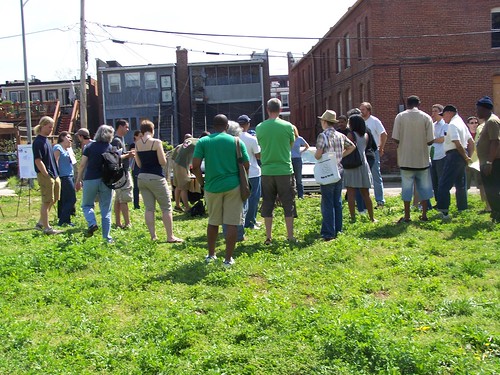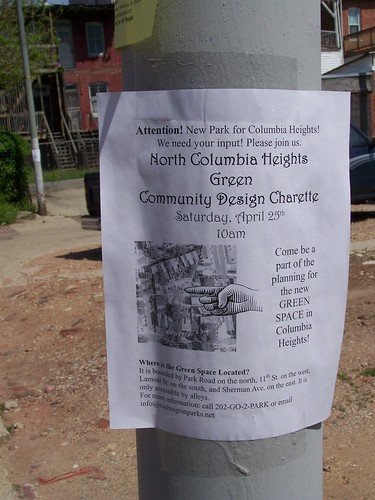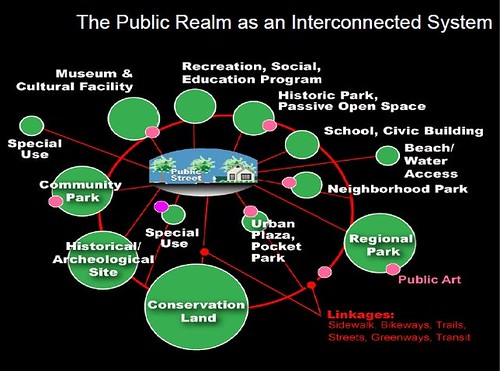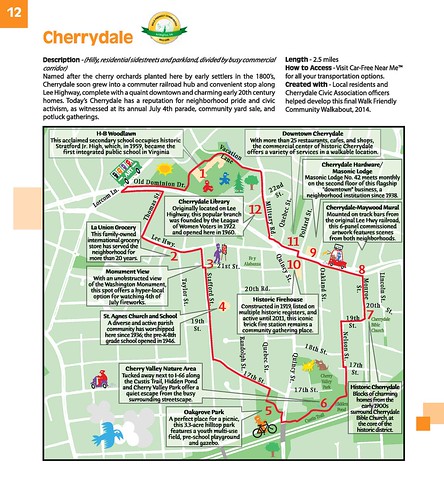Another example of the need to do comprehensive parks, recreation and civic assets planning at multiple scales, including neighborhoods like Columbia Heights
There were a couple of interesting articles in the Washington Post last week, both about the Columbia Heights neighborhood.
One article is on a boxing gym, Midtown Youth Academy, that facing rent increases and change in leadership, faces threats to its continued existence ("This DC corridor has flourished. A boxing gym for its youth is battling for its life").
The other is about a dog park that functions on land owned by WMATA, the transit agency, which is now looking to sell the land ("D.C. bid $2.1 million for a plot of dirt used as a dog park. It might not be enough").
It's called 11th and Bark, and is on the 3400 block of 11th Street NW. But the amount the city has offered is likely to pale next to offers by developers to make the site over for housing.
Together they reiterate some conclusions I came to a long time ago about parks planning and now more broadly as civic assets planning.
In both situations, I'd say it's worth considering for the public to step in in the context of parks and recreation planning.
 Columbia Heights Green planning and design charette, 2009.
Columbia Heights Green planning and design charette, 2009.But, and especially with the dog park, I think extra normal ad-hoc responses are a bad thing, it should be part of a broader plan. (And the dog park has been an issue off and on since 2009 or earlier.)
Dupont Circle cases. A relevant example is resident angst over the conversion of a rear lot "informal park" at the back of the Scottish Rite Masonic Temple on 16th Street NW in Dupont Circle ("A room without a view: Proposed DC apartments offer life underground")
And the St. Thomas Church project ("Developer, Dupont Circle groups settle St. Thomas dispute, ending fight over development," Washington Business Journal).
In both Dupont Circle cases, informal open space was/is planned to be converted into housing, to generate funds to support the ongoing operations of the parent. Residents have opposed the projects, wanting to keep the green spaces, in a neighborhood that they say has few park spaces. In neither case did they propose to buy the land.
In both the Columbia Heights and Dupont Circle cases, lack of a comprehensive parks and recreation master plan, with sub-city planning components, is an issue. So is the failure to do comprehensive community planning at the neighborhood/district scale.
1. Planning for parks, recreation, and open space plans needs to be comprehensive and consider needs at multiple scales. In DC that is at the city-wide, quadrant, district (multiple neighborhoods), and neighborhood scales.
I remember making this point in a 2008 post ("Prototyping and municipal capital improvement programs") and later in testimony about the city's parks department ("Testimony: Agency Performance Oversight, DC Department of Parks and Recreation," 2012).
This entry, on rating parks systems, has some general criteria for parks planing.
(1) breadth and quality of facilities including a mix of active and passive spaces
(2) access and equitable provision of resources
(3) whether or not there is an approved parks master plan
(4) breadth and quality of programming and special events
(5) the policies and practices for developing and operating new parks spaces (public vs. private management)
(6) level of planning and operational coordination with other parks entities within the jurisdiction
(7) innovation
(8) The presence of an integrated system of paths and greenways (and restoring park and boulevard spaces in streets) -- treating streets as linear parks
(9) capacity building efforts that also strengthen civil society
Also relevant is David Barth's concept of "High-Performance Public Spaces: A Tool For Building Great Communities".
2. Later, and this also comes up with transportation planning, I made the point that while government-led plans typically only focus on assets that the government directly controls, cultural plans (parks, arts, historic preservation, recreation, etc.) need to consider publicly owned, nonprofit, and for profit (if applicable) assets simultaneously.
Partly this comes up because in a city like DC, many of the "publicly-owned" assets are federally-controlled and they aren't necessarily managed to serve local needs.
If the local plan doesn't offer guidance with regard to resident needs, resident needs aren't likely to be addressed by the other agencies.
It's also important for scenario planning, in case something happens to the situation of management by the other entity. Not just in the DC area, this comes up with federal shutdowns of National Park Service facilities, museums, etc.
-- "Federal shutdown as another example of why local jurisdictions should have more robust contingency and master planning processes," 2013
-- "Contingency planning in parks planning: Montgomery County Maryland edition," 2013
But for other communities, it may have to do with city-county relationships or city-county/state relationships, such as a State Parks agency closing "local"parks because of financial problems.
But it could mean dealing with facilitating nonprofit or for profit recreation facilities, ranging from a Boys Club or YMCA, a yoga studio, or a boxing gym, like the one in Columbia Heights, or buying a historic building that is otherwise threatened, a museum on the rocks like the Corcoran Gallery, etc.
-- "When BTMFBA isn't enough: keeping civic assets public through cy pres review," 2016
-- "BTMFBA: the best way to ward off artist or retail displacement is to buy the building," 2016
-- "Local parks planning, the USDA's National Arboretum, and the Friends of the National Arboretum," 2015
-- "What will happen to Germantown Country Club after it closes? It could become a public park.," Memphis Commercial Appeal
-- "BTMFBA: The Old Town Theatre in Alexandria, Virginia," 2018
-- " Beijing subsidizes brick-and-mortar bookstores in digital era," China Daily
-- "Lin-Manuel Miranda and Friends Purchase Drama Book Shop," New York Times
Scenario planning gives a community options and a way to respond creatively in crisis situations when time is of the essence.
 3. Plan the public realm/civic assets as a network, at multiple scales, including neighborhoods. The funny thing about the Columbia Heights dog park is that in 2009, I participated in a more ad hoc planning process that included the creation of what is now called the Columbia Heights Green, a community garden on the inside of the block of 11th Street NW.
3. Plan the public realm/civic assets as a network, at multiple scales, including neighborhoods. The funny thing about the Columbia Heights dog park is that in 2009, I participated in a more ad hoc planning process that included the creation of what is now called the Columbia Heights Green, a community garden on the inside of the block of 11th Street NW.There are a bunch of posts I wrote on the Columbia_Heights_e-list, including a recommendation that these formal and informal spaces be organized as a network:
One of the things I recommended at the session was for people/the neighborhood to plan the parks (we also evaluated the unofficial WMATA dog park and the triangle park at Park and Sherman; and I'd add other spaces such as the nearby school playground, in use that day for a kickball fundraiser) together, [and] create a "parks trail-wayfinding" system linking the various CH green assets.I don't remember, but this must have influenced what I wrote in 2012, "The layering effect: how the building blocks of an integrated public realm set the stage for community building and Silver Spring, Maryland as an example," contrasting Columbia Heights and Silver Spring, and arguing that Silver Spring was in a much better position, with a more defined, but still somewhat informally planned, network of spaces, strengthened by a schedule of anchor events.
Also see:
-- "Town-city management: "We are all asset managers now"," 2015
-- "Municipal Natural Assets Planning Initiative, British Columbia," 2018
The conceptual graphic created by parks planner David Barth has definitely influenced my thinking about this.

The Arlington County WalkArlington map for the Cherrydale is a good example of how to conceptualize such a network at the neighborhood scale. (There is a similar graphic, showing this concept in Boulder, in the book Reclaiming Our Cities and Towns: Better Living Through Less Traffic, by David Engwicht.)

Labels: civic assets, cultural planning, integrated public realm framework, parks planning, provision of public services, urban design/placemaking




1 Comments:
Similar situation in the Globeville neighborhood of Denver.
https://www.denverpost.com/2023/01/18/beast-fingers-climbing-gym-serves-underprivileged-avoids-eviction
"Beast Fingers climbing gym that serves underprivileged youths in Globeville avoids eviction"
The gym, which has served underprivileged youths in one of Denver’s poorest neighborhoods since 2017, received an infusion of cash from Adidas that allowed owner Aman Anderson to pay his back rent. A court date regarding the threatened eviction that had been set for Wednesday was canceled.
Adidas, which had been subsidizing the gym, cut its funding last fall. But with the gym facing imminent eviction and permanent closure, the general manager for Adidas Outdoor-North America, Michael Kadous, stepped in to help Anderson pay his past due rent this week and offered more help going forward so the gym can stay open.
“Adidas wants me to create a plan that they can get behind and then they will support it,” Anderson said. “I guess what Michael’s concern is, he doesn’t want the gym to always be in an emergency. The plan right now is to create a non-profit arm for the gym so that funding can continue.”
Post a Comment
<< Home